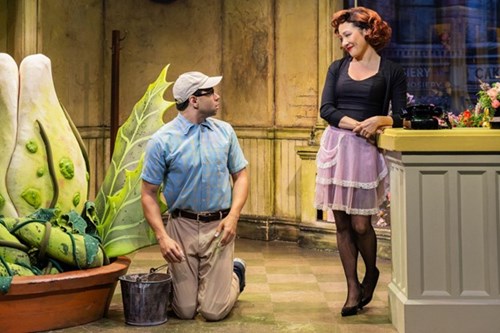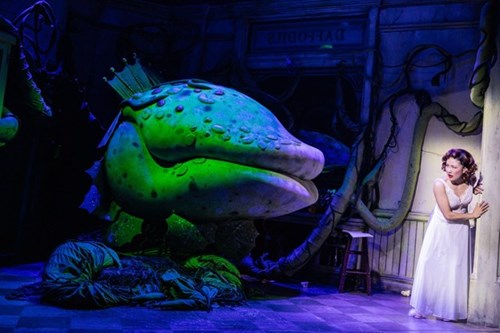
In the vast and vibrant history of American theater, few musicals are as unique and enduring as Little Shop of Horrors. First premiering off-Broadway in 1982, the musical quickly carved a niche for itself with its distinct mix of horror, comedy, and rock-n-roll, ultimately reaching Broadway in 2003. Based on the 1960 film, the now-iconic musical remains an exemplary display of creative storytelling and innovative effects.
At the center stage of Little Shop of Horrors is an unusual, green singing plant named Audrey II. It is, arguably, one of the most memorable characters in Broadway history. The larger-than-life Audrey II starts as a unique plant, somewhat innocent and mystifying, but morphs into a menacing, human-eating villain throughout the course of the musical. Beyond its narrative significance, Audrey II exemplifies the show's playful creativity and embodies the potential for special effects to fundamentally shape a performance.
The original conception of Audrey II was as unique and riveting as the character itself. Without an existing template—since nothing quite like this had ever ventured onto a theater stage—the task fell to puppeteer Martin P. Robinson, who designed, built, and performed Audrey II for the original production and later for the 2003 Broadway version. Robinson's ingenuity and phenomenal puppetry brought forth a life-like, engaging, and thoroughly entertaining character that mesmerized audiences around the world.

The present hit Off-Broadway production brought multiple creatives together to re-imagine this iconic character. Nicholas Mahon, a puppeteer known for his intricate and visually stimulating designs, modeled Audrey II's design on Robinson's, maintaining the original feel while innovating where necessary. The mechanical design and construction were handled by Monkey Boys Productions, ensuring that Audrey II's movements were as realistic and impressive as ever.
Mahon's vision of Audrey II was one of contrast—voluptuous yet frightening. He utilized airbrushing for the general tinting of the plant, applying it sparingly to retain a somewhat raw and untamed look. Inside, multiple dangling teeth and small nubs created an image of impending danger.
In the 2003 production, the fully grown Audrey II was a mechanized marvel. Hydraulic tendrils would shoot high and wide above the orchestra and close to the audience in the balcony seats. Flash forward to the present iteration, where tradition mingles effortlessly with novelty. The plant now evolves through four different puppet sizes — known as 'pods.' The monstrous Pod 4 becomes as gigantic as a Smart car and is people-driven. Inside this Leviathan puppet, controlling Audrey II is no minor undertaking. It requires the synchronized efforts of four puppeteers. Strapped under Audrey II's shell of spandex and painted fiberglass, these artists animate the plant, bringing it to life in its entire horrifying glory.
A key factor in the changes of Audrey II was the shift in available technology. Over the years, advancements in design and mechanics have led to more complex and lifelike puppetry. Audrey II's stage presence and the audience's proximity also played a critical role in the design changes. To directly engage the audience into Audrey II’s story, it was necessary to create a design that was both larger-than-life and capable of intricate movements.
The journey from envisioning Audrey II to actually bringing it alive on stage was paved with a multitude of challenges. Audrey II was expected to not only grow in size over the course of the performance but to eventually talk, sing, dance, and ‘eat’ the entire cast. It was a massive undertaking, rife with technical complexities and requiring out-of-the-box creativity.
Among the challenges was the need for Audrey II to convincingly evolve in size from a small, unassuming sprout to an imposing, sinister figure. This demanded a design that could undergo transformations throughout the show, all while holding the audience’s attention.
The second challenge was that Audrey II had to move in ways suggesting human-like traits. Creating a giant puppet capable of the meticulous mouth and tendril movements needed for singing, talking, and even devouring characters was a formidable task. Synchronizing these movements with the actor's lines and on-stage dynamics presented another layer of complexity.
Martin P. Robinson, the original puppeteer behind Audrey II, exhibited exceptional ingenuity and creativity from the start. He was tasked with an almost impossible task. Ever optimistic, he focused on the possibilities instead of the difficulties. One of Robinson's standout solutions was the use of a fake arm to control the plant. This trick allowed Audrey II to appear animated without any visible puppeteers, lending a sense of realism to the amateur botanist Seymour's engagement with the plant. It was an elegant solution, low-cost yet highly effective, showing that sometimes simplicity can win over high-tech.

In the revival, Nicholas Mahon was confronted with the legacy of Audrey II and the expectations it carried. Mahon took the challenge head-on, respecting the original while also introducing new elements to enhance the plant’s enigmatic presence. He maintained fidelity to Robinson's original design but updated it to cater to modern theatrical environments and audience demands.
Sound effects add another layer to Audrey II’s character. The creature sounds—the rumble of satisfaction after Audrey II 'eats' a character contributes to the overall horrifying effect. Moreover, the voice of Audrey II, teeming with sinister charisma, plays a key role, achieved through a blending of live and recorded audio.
One of the most critical aspects of representing Audrey II is achieving perfect lip-syncing to the character's voice. The voice of Audrey II, facilitated off-stage, underpins the terrifying yet oddly charismatic personality of the plant. The puppeteer's meticulous movements of Audrey II’s mouth, synchronized with the voice, make the dialogue and singing appear to be emanating from the plant. This coordination can make or break the immersive experience for the audience—amply demonstrating the significance of lip-syncing for Audrey II’s character.
The choice of voice actor for Audrey II is equally crucial, given the character's vocal-centric role. The voice needs to bridge the gap between being terrifyingly monstrous yet enamorably flamboyant. This duality helps to emphasize the deceptive charm of Audrey II, drawing the audience into its diabolical scheme. Aaron Arnell Harrington's rich and soulful bass-baritone voice currently embodies Audrey II in sound, breathing new life into the bloodthirsty plant, combining threat with allure in his performance.
This unique musical, blending comedy, horror, sci-fi, vibrant characters, and captivating music, remains a camp classic in the theatre world. The allure of Little Shop of Horrors lies in its unabashed embrace of dark humor, wrapped in toe-tapping music and splashed with neon-bright campiness. Its success spans decades and generations, remaining relevant and adored, an emblem of imaginative storytelling and theatrical innovation.
At its heart, Audrey II stands tall, as menacing and endearingly wicked as ever. Creating Audrey II was a monumental theatrical endeavor, a testament to the limitless possibilities of stagecraft. The deeply intricate, painstakingly realistic puppetry, married with expressive special effects and the unforgettable voice of Aaron Arnell Harrington, continues to mesmerize audiences, making Audrey II the undisputed star of the show.
Feel the thrill of this bizarre journey, live the story that merges science fiction with human aspiration, and meet the most charmingly sinister plant that ever graced the stage. Gather your courage, prepare your nerves, and step into the world of Little Shop of Horrors. Discover why it continues to be a beloved classic and why it'll forever occupy a unique place in Broadway's heart. Don’t just listen to the tale, live it in Off-Broadway's memorable production. A world of chills, thrills, laughter, and shocks awaits you!